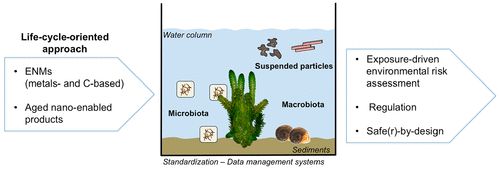当前位置:
X-MOL 学术
›
Environ. Sci. Technol.
›
论文详情
Our official English website, www.x-mol.net, welcomes your
feedback! (Note: you will need to create a separate account there.)
Aquatic Mesocosm Strategies for the Environmental Fate and Risk Assessment of Engineered Nanomaterials
Environmental Science & Technology ( IF 10.8 ) Pub Date : 2021-12-02 , DOI: 10.1021/acs.est.1c02221 Andrea Carboni 1 , Danielle L Slomberg 1 , Mohammad Nassar 1 , Catherine Santaella 2 , Armand Masion 1 , Jerome Rose 1, 3 , Melanie Auffan 1, 3
Environmental Science & Technology ( IF 10.8 ) Pub Date : 2021-12-02 , DOI: 10.1021/acs.est.1c02221 Andrea Carboni 1 , Danielle L Slomberg 1 , Mohammad Nassar 1 , Catherine Santaella 2 , Armand Masion 1 , Jerome Rose 1, 3 , Melanie Auffan 1, 3
Affiliation

|
In the past decade, mesocosms have emerged as a useful tool for the environmental study of engineered nanomaterials (ENMs) as they can mimic the relevant exposure scenario of contamination. Herein, we analyzed the scientific outcomes of aquatic mesocosm experiments, with regard to their designs, the ENMs tested, and the end points investigated. Several mesocosm designs were consistently applied in the past decade to virtually mimic various contamination scenarios with regard to ecosystem setting as well as ENMs class, dose, and dosing. Statistical analyses were carried out with the literature data to identify the main parameters driving ENM distribution in the mesocosms and the potential risk posed to benthic and planktonic communities as well as global ecosystem responses. These analyses showed that at the end of the exposure, mesocosm size (water volume), experiment duration, and location indoor/outdoor had major roles in defining the ENMs/metal partitioning. Moreover, a higher exposure of the benthic communities is often observed but did not necessarily translate to a higher risk due to the lower hazard posed by transformed ENMs in the sediments (e.g., aggregated, sulfidized). However, planktonic organisms were generally exposed to lower concentrations of potentially more reactive and toxic ENM species. Hence, mesocosms can be complementary tools to existing standard operational procedures for regulatory purposes and environmental fate and risk assessment of ENMs. To date, the research was markedly unbalanced toward the investigation of metal-based ENMs compared to metalloid- and carbon-based ENMs but also nanoenabled products. Future studies are expected to fill this gap, with special regard to high production volume and potentially hazardous ENMs. Finally, to take full advantage of mesocosms, future studies must be carefully planned to incorporate interdisciplinary approaches and ensure that the large data sets produced are fully exploited.
中文翻译:

工程纳米材料的环境命运和风险评估的水生中宇宙策略
在过去十年中,中宇宙已成为工程纳米材料 (ENM) 环境研究的有用工具,因为它们可以模拟相关的污染暴露场景。在这里,我们分析了水生中宇宙实验的科学成果,包括它们的设计、测试的 ENM 和调查的终点。在过去的十年中,一些中宇宙设计一直被应用,以虚拟模拟关于生态系统环境以及 ENM 类别、剂量和剂量的各种污染情景。对文献数据进行了统计分析,以确定驱动 ENM 在中宇宙分布的主要参数以及对底栖和浮游群落以及全球生态系统响应构成的潜在风险。这些分析表明,在曝光结束时,中宇宙大小(水量)、实验持续时间和室内/室外位置在定义 ENM/金属分区方面起主要作用。此外,经常观察到较高的底栖生物群落暴露量,但由于沉积物中转化的 ENM(例如,聚集的、硫化的)造成的危害较低,因此不一定转化为较高的风险。然而,浮游生物通常暴露于较低浓度的潜在更具反应性和毒性的 ENM 物种。因此,中观宇宙可以成为现有标准操作程序的补充工具,用于监管目的以及 ENM 的环境归宿和风险评估。迄今为止,与准金属和碳基 ENM 以及纳米产品相比,该研究在金属基 ENM 的研究方面明显不平衡。未来的研究有望填补这一空白,特别是高产量和潜在危险的 ENM。最后,为了充分利用中宇宙,必须仔细规划未来的研究,以纳入跨学科方法,并确保充分利用所产生的大型数据集。
更新日期:2021-12-21
中文翻译:

工程纳米材料的环境命运和风险评估的水生中宇宙策略
在过去十年中,中宇宙已成为工程纳米材料 (ENM) 环境研究的有用工具,因为它们可以模拟相关的污染暴露场景。在这里,我们分析了水生中宇宙实验的科学成果,包括它们的设计、测试的 ENM 和调查的终点。在过去的十年中,一些中宇宙设计一直被应用,以虚拟模拟关于生态系统环境以及 ENM 类别、剂量和剂量的各种污染情景。对文献数据进行了统计分析,以确定驱动 ENM 在中宇宙分布的主要参数以及对底栖和浮游群落以及全球生态系统响应构成的潜在风险。这些分析表明,在曝光结束时,中宇宙大小(水量)、实验持续时间和室内/室外位置在定义 ENM/金属分区方面起主要作用。此外,经常观察到较高的底栖生物群落暴露量,但由于沉积物中转化的 ENM(例如,聚集的、硫化的)造成的危害较低,因此不一定转化为较高的风险。然而,浮游生物通常暴露于较低浓度的潜在更具反应性和毒性的 ENM 物种。因此,中观宇宙可以成为现有标准操作程序的补充工具,用于监管目的以及 ENM 的环境归宿和风险评估。迄今为止,与准金属和碳基 ENM 以及纳米产品相比,该研究在金属基 ENM 的研究方面明显不平衡。未来的研究有望填补这一空白,特别是高产量和潜在危险的 ENM。最后,为了充分利用中宇宙,必须仔细规划未来的研究,以纳入跨学科方法,并确保充分利用所产生的大型数据集。











































 京公网安备 11010802027423号
京公网安备 11010802027423号